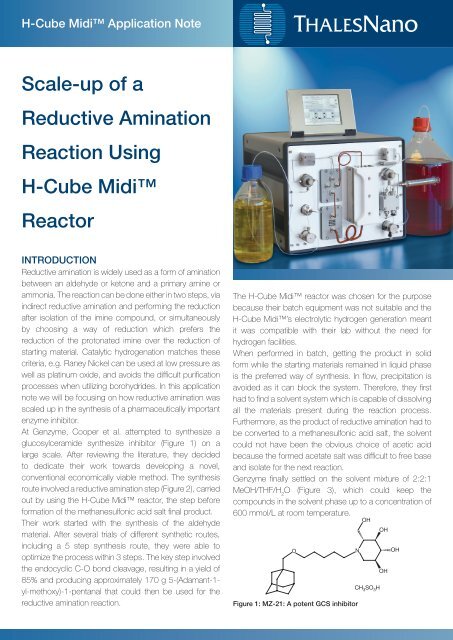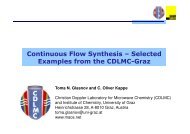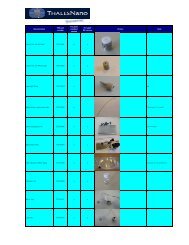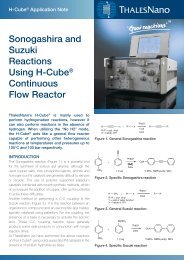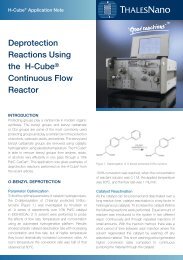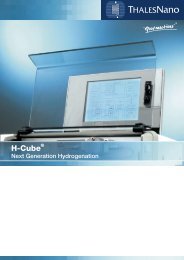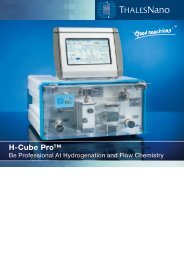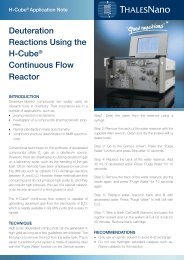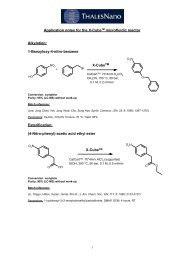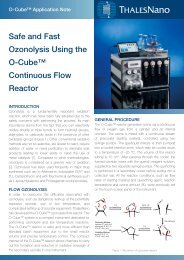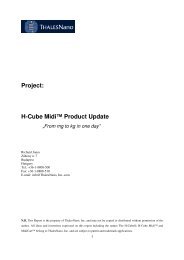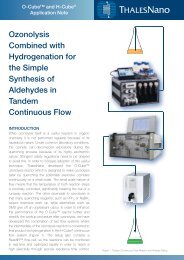Scale-up of a Reductive Amination Reaction Using H-Cube Midi ...
Scale-up of a Reductive Amination Reaction Using H-Cube Midi ...
Scale-up of a Reductive Amination Reaction Using H-Cube Midi ...
Create successful ePaper yourself
Turn your PDF publications into a flip-book with our unique Google optimized e-Paper software.
H-<strong>Cube</strong> <strong>Midi</strong> Application Note<br />
<strong>Scale</strong>-<strong>up</strong> <strong>of</strong> a<br />
<strong>Reductive</strong> <strong>Amination</strong><br />
<strong>Reaction</strong> <strong>Using</strong><br />
H-<strong>Cube</strong> <strong>Midi</strong><br />
Reactor<br />
INTRODUCTION<br />
<strong>Reductive</strong> amination is widely used as a form <strong>of</strong> amination<br />
between an aldehyde or ketone and a primary amine or<br />
ammonia. The reaction can be done either in two steps, via<br />
indirect reductive amination and performing the reduction<br />
after isolation <strong>of</strong> the imine compound, or simultaneously<br />
by choosing a way <strong>of</strong> reduction which prefers the<br />
reduction <strong>of</strong> the protonated imine over the reduction <strong>of</strong><br />
starting material. Catalytic hydrogenation matches these<br />
criteria, e.g. Raney Nickel can be used at low pressure as<br />
well as platinum oxide, and avoids the difficult purification<br />
processes when utilizing borohydrides. In this application<br />
note we will be focusing on how reductive amination was<br />
scaled <strong>up</strong> in the synthesis <strong>of</strong> a pharmaceutically important<br />
enzyme inhibitor.<br />
At Genzyme, Cooper et al. attempted to synthesize a<br />
glucosylceramide synthesize inhibitor (Figure 1) on a<br />
large scale. After reviewing the literature, they decided<br />
to dedicate their work towards developing a novel,<br />
conventional economically viable method. The synthesis<br />
route involved a reductive amination step (Figure 2), carried<br />
out by using the H-<strong>Cube</strong> <strong>Midi</strong> reactor, the step before<br />
formation <strong>of</strong> the methanesulfonic acid salt final product.<br />
Their work started with the synthesis <strong>of</strong> the aldehyde<br />
material. After several trials <strong>of</strong> different synthetic routes,<br />
including a 5 step synthesis route, they were able to<br />
optimize the process within 3 steps. The key step involved<br />
the endocyclic C-O bond cleavage, resulting in a yield <strong>of</strong><br />
85% and producing approximately 170 g 5-(Adamant-1yl-methoxy)-1-pentanal<br />
that could then be used for the<br />
reductive amination reaction.<br />
The H-<strong>Cube</strong> <strong>Midi</strong> reactor was chosen for the purpose<br />
because their batch equipment was not suitable and the<br />
H-<strong>Cube</strong> <strong>Midi</strong>’s electrolytic hydrogen generation meant<br />
it was compatible with their lab without the need for<br />
hydrogen facilities.<br />
When performed in batch, getting the product in solid<br />
form while the starting materials remained in liquid phase<br />
is the preferred way <strong>of</strong> synthesis. In flow, precipitation is<br />
avoided as it can block the system. Therefore, they first<br />
had to find a solvent system which is capable <strong>of</strong> dissolving<br />
all the materials present during the reaction process.<br />
Furthermore, as the product <strong>of</strong> reductive amination had to<br />
be converted to a methanesulfonic acid salt, the solvent<br />
could not have been the obvious choice <strong>of</strong> acetic acid<br />
because the formed acetate salt was difficult to free base<br />
and isolate for the next reaction.<br />
Genzyme finally settled on the solvent mixture <strong>of</strong> 2:2:1<br />
MeOH/THF/H 2 O (Figure 3), which could keep the<br />
compounds in the solvent phase <strong>up</strong> to a concentration <strong>of</strong><br />
600 mmol/L at room temperature.<br />
Figure 1: MZ-21: A potent GCS inhibitor
During the optimization process several catalysts<br />
(Figure 4) and conditions were tested in order to get<br />
the highest throughput in a single pass. Due to the<br />
difficulties associated with removal <strong>of</strong> the residues <strong>of</strong> the<br />
amine compound (deoxynojirimycin), although conversion<br />
was higher than 98% using equimolar amounts, an excess<br />
<strong>of</strong> 1.6 equ. aldehyde was needed. This helped avoid a<br />
highly problematic work<strong>up</strong> procedure.<br />
EXPERIMENTAL PROCEDURE<br />
The aldehyde compound was dissolved in THF/MeOH<br />
and was merged with the aqueous solution <strong>of</strong><br />
deoxynojirmicin and filtered before pumping into the<br />
H-<strong>Cube</strong> <strong>Midi</strong> reactor. The following reaction parameters<br />
were set: temperature: 145 °C, pressure: 95 bar, flow rate:<br />
15 mL/min, catalyst: Pd(OH) 2 /C. After evaporation, the<br />
product was reacted with methanesulfonic acid to form<br />
130.9 g <strong>of</strong> the final product with a 99.4% purity after<br />
filtration and drying. This H-<strong>Cube</strong> <strong>Midi</strong> step is capable <strong>of</strong><br />
producing 1 kg <strong>of</strong> compound per day on one <strong>Midi</strong>Cart.<br />
No catalyst deactivation was observed. ICP studies<br />
showed less than 1 ppm residual Pd content.<br />
Conversion / %<br />
100<br />
Figure 3: Solvent choice: 2:2:1 MeOH/THF/H 2 O<br />
ThalesNano Nanotechnology Inc.<br />
0<br />
Zahony u. 7.<br />
H-1031 Budapest<br />
Hungary<br />
Tel.: +36 1 880 8500<br />
Fax: +36 1 880 8501<br />
E-mail: sales@thalesnano.com<br />
80<br />
60<br />
40<br />
20<br />
US Office ThalesNano<br />
50 S. Penn St. Suite B-2<br />
Hatboro<br />
Flow Rate / mL/min<br />
PA. 19040<br />
USA<br />
Phone: +1 732 274 3388<br />
E-mail: USAsales@thalesnano.com<br />
5 7 9 11 13 15 17 19 21 23 25<br />
Figure 2: <strong>Reductive</strong> amination in flow<br />
H-<strong>Cube</strong> <strong>Midi</strong> Application Note<br />
CONCLUSION<br />
A novel route was developed to synthesize a biologically<br />
active compound. By applying flow hydrogenation<br />
they were able to produce the desired compound<br />
in the required scale with less than 1 ppm residual<br />
Pd content. Considering the used concentration<br />
and flow rate, the described process was capable<br />
<strong>of</strong> producing 1 kg <strong>of</strong> the reductive aminated product<br />
per day.<br />
REFERENCES<br />
Cooper, C.G.F.; Lee, E.R.; Silva, R.A.; Bourque, A.J.; Clark,<br />
S.; Katti, S.; Nivororozhkin, V.; Process Development <strong>of</strong> a<br />
Potent Glucosylceramide Synthase Inhibitor; Org. Process<br />
Res. Dev.; 2011; In press<br />
Conversion / %<br />
100<br />
80<br />
60<br />
40<br />
20<br />
Pd(OH) 2<br />
on C<br />
Pd on C<br />
Pt/C<br />
RaNi<br />
0<br />
5 7 9 11 13 15 17 19 21 23 25<br />
Flow Rate / mL/min<br />
Figure 4: Optimization <strong>of</strong> flow rate and catalyst<br />
UK Office<br />
Carl Jones<br />
Head <strong>of</strong> European Sales<br />
Tel.: +44 (0) 7868 843 819<br />
E-mail: UKsales@thalesnano.com<br />
Pd(OH) 2<br />
Pd on C<br />
Pt/C<br />
RaNi


